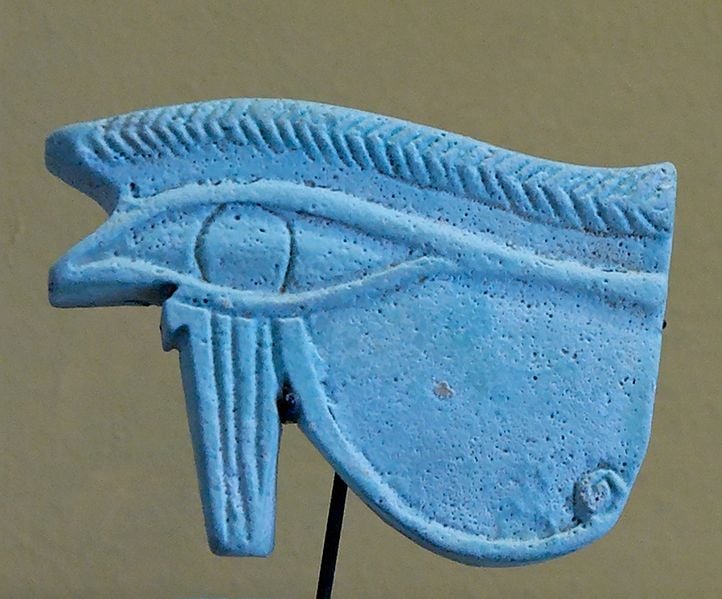
Louvre Museum
Hanging a chain of small blue beads featuring a blue eye from the mirror in a car, or placing a painting or ceramic blue hand, hamsa, on a store or front door of a house are all part of a special Egyptian tradition.
Egyptians believe that these small objects will protect them from any evil spirit, envy or jealousy (hassad) that is directed at them and which has the ability of ruining their life or damaging their prized possessions.
Hassad or envy is a feeling that many people encounter at some point, even if they have the best of intentions. Jealousy of other people’s good fortune, luck, achievements or possessions can be a fleeting emotion or can turn into downright envy.
In Egypt, as in many other nations, people believe that this feeling represents a strong, hidden and evil power which may result in damage or loss of what is envied or the injury and bad luck of its possessor. Looking at someone with envy is called the evil eye, the eye of jealousy or aien al-hasoud in Arabic.
In order to protect themselves from this evil power Egyptians tend to hang the blue ornaments or other objects on the possessions that may generate envy. In some rural villages around Egypt families give their children made up and meaningless names like Khesha or Hoksha to keep the evil eye off them. Other habits, like leaving blooded handprints from offered animals on the walls of houses or prickly small white dolls on a sting are also believed to keep away hassad.
“When my mother lost my twin, she changed my name to Oakel, in order to keep the neighbours’ jealous evil eyes off me,” said Hajj Oakel, owner of a local bath house, justifying the reason behind his unusual name.
Other practices to guard babies from the evil eye, besides giving them weird names, include piercing the ears of boys so people will think they are girls, who are considered of lesser value, taking them to live somewhere else for longer periods of time, or outright lying and telling people that they are sick or failed exams when in fact they are healthy or passed.
The habits of hanging blue bead pendants, dangling an old shoe from a car or cleansing houses with burning herbs to protect from the evil power of hassad have historical sources; the pharaohs believed in the evil eye of envy and used to engrave their figures on blue marbles as a protection. The population of Old Egypt used to wear necklaces of blue marbles with pendants and draw and hang figures featuring the eye of Horus around their houses for the same purpose.
The term hassad is mentioned in the Quran; Muslims believe that reciting a certain Quran chapter every day will protect them from hassad. It is expected that any Muslim will say “Masha’Allah” (it is Allah’s will), whenever his or her good fortune is mentioned by others, like his good health or the beauty of his wife or baby, in order to bless them and protect them from hassad.
Fear of evil eye and jealousy is an integral part of Egyptian life, so do not be surprised to see a man pretend to be sick or cough whenever his good health is mentioned by his friends, see women wear necklaces featuring a blue eye, an eye of Horus or a beautiful Kufic calligraphy of masha’Allah or Quranic verses, or folkloric idioms attached to the back of cars asking others not to cast an evil eye on their vehicle.
Evil Eye Talisman Dates Back to Ancient Egypt
The belief in the evil eye dates back to ancient Egypt. In Egyptian mythology, Osiris was the god of life, his sister Isis was the goddess of magic, and their other brother Seth was the god of evil.
One day, Seth became angry with Osiris because he had married Isis. He plotted to kill his brother, and one night while Osiris was asleep, Seth took his measurements and made a beautiful crate. He then invited Osiris to a feast and gave him the crate to test. As Osiris stepped inside, Seth and his guards trapped him inside and threw the crate into the Nile River.
Isis was devastated when she learned of her husband’s death. She used her magic to search for him everywhere, and eventually she found the crate. Osiris was already dead, but Isis hid the crate and attempted to bring him back to life. However, Seth found the crate and divided Osiris’s body into 14 pieces, scattering them all over the world.
Isis eventually found all of Osiris’s pieces and brought him back to life, but he was unable to speak, see, or hear. Their son Horus, also known as the “sun and moon eye,” waged war against his uncle Seth to avenge his father. Although Seth lost the war, he took out Horus’s eye.
Horus pieced together his eye, and then gave his own eye to his father to help him regain his strength. Osiris ate his son’s eye and regained his powers. The sun god Ra then made Horus the king of Egypt, while Osiris became the king of the dead.




